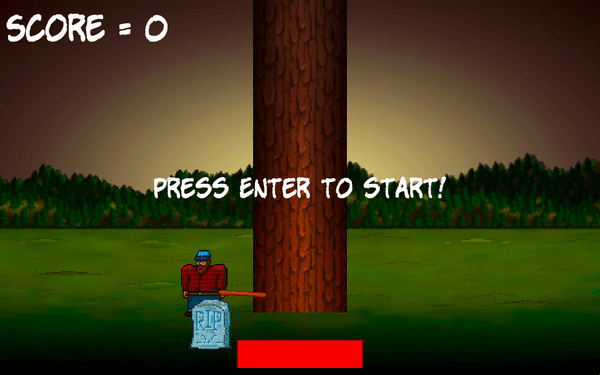showcase
Intro
SFML is a C++ library for a simple application programming interface to various multimedia components in computers.
Timberman is a 2D retro-style casual game, where the player controls a timberman (left/right arrow keys) to chop a tree and dodge branches.
The game was built from scratch using the SFML library, based on the “Learning Path: C++ Game Programming” course.

Motivation
The original tutorial code is straightforward to implement the Timberman gameplay.
It is great to learn SFML for the first time, but the code is less reusable and extensible.
By rewriting the code base, I made it as a more general engine for similar games based on 2D sprites.
Contributions
There are two key contributions: abstracting game actors and organising the game loop.
Abstracting game actors
Observation: creating similar things repetitively, and drawing each sprite manually.
// From the original tutorial code file
...
// Prepare the player
sf::Texture texturePlayer;
texturePlayer.loadFromFile(resourcePath() + "graphics/player.png");
sf::Sprite spritePlayer;
spritePlayer.setTexture(texturePlayer);
spritePlayer.setPosition(580, 720);
// Prepare the gravestone
sf::Texture textureRIP;
textureRIP.loadFromFile(resourcePath() + "graphics/rip.png");
sf::Sprite spriteRIP;
spriteRIP.setTexture(textureRIP);
spriteRIP.setPosition(600, 860);
// Prepare the axe
sf::Texture textureAxe;
textureAxe.loadFromFile(resourcePath() + "graphics/axe.png");
sf::Sprite spriteAxe;
spriteAxe.setTexture(textureAxe);
spriteAxe.setPosition(700, 830);
// And more repetitions ...
...
// Draw the player
window.draw(spritePlayer);
// Draw the gravestone
window.draw(spriteRIP);
// Draw the axe
window.draw(spriteAxe);
// And more repetitions ...
...
Solution: abstracting game actors as an Actor class base.
// Actor.cpp
#include "Actor.hpp"
// Define a static vector to record all actors
std::vector<Actor*> Actor::sVectorActorPtr;
Actor::Actor(std::string strSpritePath) : m_fSpeedX(0.0f), m_fSpeedY(0.0f), m_bIsHidden(false)
{
// Set the sprite given the full path of a texture
std::string strFullPath = resourcePath() + strSpritePath;
if (m_texture.loadFromFile(strFullPath))
{
m_sprite.setTexture(m_texture);
}
// Record the pointer of this actor
Actor::sVectorActorPtr.push_back(this);
}
...
void Actor::drawActors(sf::RenderWindow& window)
{
// Draw the sprite of all actors
for (auto pActor : Actor::sVectorActorPtr)
{
if (pActor != nullptr && !pActor->m_bIsHidden)
{
window.draw(pActor->getSprite());
}
}
}
...
Organising the game loop
Observation and solution: dividing functionalities of the Timberman game into 6 classes:
GameEngine, GameUI, GameManager, Actor, Tree(Actor), Player(Actor).
// main.cpp
#include "GameEngine.hpp"
int main()
{
GameEngine gameEngine;
gameEngine.run();
return EXIT_SUCCESS;
}
// GameEngine.cpp
...
void GameEngine::run()
{
// Start the game loop
while (window.isOpen())
{
input();
update();
draw();
}
}
...
// GameEngine.hpp
#pragma once
#include <SFML/Graphics.hpp>
#include "GameUI.hpp"
#include "GameManager.hpp"
#include "Actor.hpp"
#include "Tree.hpp"
#include "Player.hpp"
class GameEngine
{
public:
GameEngine();
void run();
private:
void input();
void update();
void draw();
sf::RenderWindow m_window;
float m_fWindowWidth;
float m_fWindowHeight;
GameUI m_gameUI;
GameManager m_gameManager;
Actor m_actorBackground;
Tree m_actorTree;
Player m_actorPlayer;
};